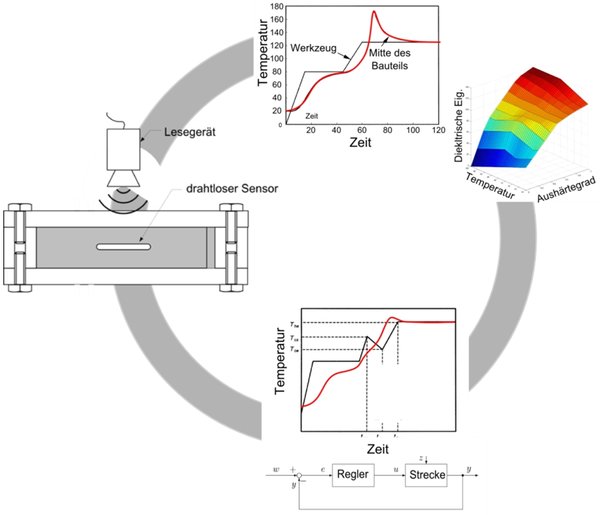Project leader: Prof. Dr.-Ing. G. Ziegmann
Funding period: 03/2014 - 02/2016
Funding body: DFG
Funding code: DFG Zi 648/34-1
Contact: M.Sc. Mehdi Javdanitehran
The quality and mechanical properties of fiber-reinforced plastics (FRP) depend largely on the processing of the matrix during the curing process. Precise analytical process control is difficult due to the complex relationships between the geometry of the component and the reaction kinetics of the resin system used. Particularly with real systems, such as thick-walled components, transferability is only possible to a limited extent. On-line monitoring of the processes is therefore necessary. The dielectric method has established itself as a reliable, integrable variant. However, current measuring systems are only used to a limited extent due to the cable-guided sensors.
The aim of this project is to develop a wireless sensor system for the non-destructive real-time recording of the degree of curing and the reaction temperature during the production of fiber composite plastics. As part of a collaboration with the Chair of High Frequency Technology at the University of Erlangen, the relevant measured variables are recorded with a new type of microwave resonator (for the electrical variables and also the temperature) in the form of a passive RFID sensor and correlated with the actual degree of curing. Previous limitations (cable guides in the mold and component, weak points due to cable passages) can be circumvented with such a compact arrangement. Based on the signals from the sensors and the knowledge of the relationship between the reaction chemistry and the dielectric properties, the process can be modified on-line in a targeted manner via the local control of the temperature control system. As a result, unfavourable curing can be avoided and the cycle time optimized.
These sensors can also be used to monitor the impregnation phase. The further use of the sensor after curing as a multifunctional system for strain measurement for structural health monitoring (SHM) is being investigated as part of this project. This system can be used as a holistic, multifunctional monitoring system throughout the entire service life of a component, from manufacture to operation.
